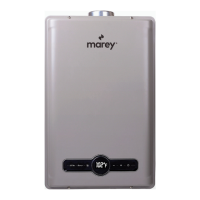3.4 ELECTRICAL
3.5 GAS PIPING
1. Check the fuel gas type before installation. DO NOT connect a unit if the gas type is not
compatible. Contact Marey for the proper unit to match the gas type.
2. Check the gas inlet pressure immediately upstream at a location provided by the gas company.
Ensure the gas pressure is within the limits shown in the Specications section.
3. Review the installation location taking into account all gas users on site. Calculate the gas
piping that will be required to service the installation. The gas supply line shall be sized and
installed to provide a supply of gas sufcient to meet the maximum demand of the heater and
all other gas consuming appliances at the location.
Note: Reference the National Fuel Gas Code, NFPA 54, for proper line sizing.
4. Ensure any compound used on the threaded joints of the gas piping is compatible with
LPG/Propane.
5. Use only approved materials to connect the unit to the gas line.
6. Install a manual gas valve in the gas supply line to the water heater. For best performance the
water heater should be the rst user downstream from the gas supply meter. A union can be
used on the heater sized of the valve to allow for future servicing or disconnection of the unit.
7. Purge the gas line of any debris before connection to the water heater.
8. Connect to the water heater.
9. Leak check all joints including the heater for gas tightness. Use a leak detection solution,
soap and water, or an equivalent nonammable solution, as applicable.
24
Ensure compliance with applicable electrical codes during installation
including the U.S. National Electric Code (NFPA 70) or the Canadian
Electrical Code – Part 1 (CGAS C22.1) depending on location.
Ensure that a properly grounded 120 V/ 60 Hz three prong outlet is available.
DO NOT PLUG IN THE UNIT UNTIL INSTALLATION IS COMPLETE,
TESTED, AND READY FOR INITIAL START UP.
Gas piping should be sized, installed, and tested only by a licensed
professional! Improper installation can result in improper equipment
performance or a hazardous situation.
Ensure any leak check solution is non-corrosive and is completely
rinsed from the piping after leak check is complete. Corrosion of the
gas piping and subsequent leaks could occur.
Never use ammable solutions or an open ame to test for gas leaks!

